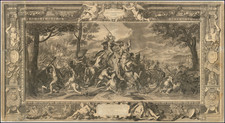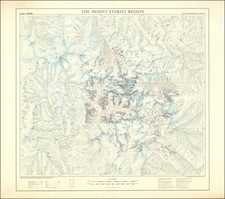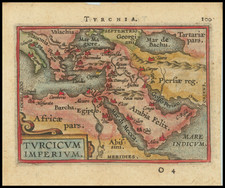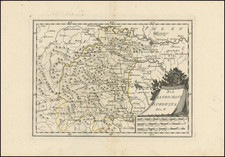The Tabula Asiae II, part of the 1574 edition of Girolamo Ruscelli's edition of Ptolemy's Geographia, is a noteworthy example of Renaissance cartography inspired by ancient geographical knowledge. This particular map displays various key features and geographical locations, merging historical understanding with the cartographical techniques of Ruscelli's time.
On the lower left side of the map, the Black Sea or 'Mae Otis Palus' is featured, connecting to the Bosphorus Straits. The representation of this strategic waterway demonstrates its importance in facilitating connections between the East and West.
In contrast, the northeastern Caspian Sea or 'Hyrcan Maris' is represented on the lower right corner of the map. Its depiction on the boundary underlines the limited knowledge of this region during the time. Surrounding areas are indicated with gentle lines, potentially implying a hilly or mountainous landscape.
Moving northward, the map extends to 'Hyperborei monte,' likely referring to a mountainous region beyond the North Wind according to Greek mythology. Its representation seems to symbolize the unexplored and mythical aspects of geographical knowledge during the era.
There are several distinct locations mentioned on the map, such as 'Arae Caesaris,' and 'Arae Alexandri,' which refer to the altars of Caesar and Alexander respectively. The 'Alexandri Columnae,' or Pillars of Alexander, offer a historical dimension to the map, possibly indicating sites of military victories or constructions.
'Pilae Albaniae' and 'Porte Sarmaticae' are also named, suggesting these could be important geographical or man-made features of the period. Their presence provides valuable insights into the local geography and possibly trade routes or boundary demarcations.
The map is centered around 'Hippici montes,' or the horse mountains, indicating the cultural or economic significance of horses in this region during the period.
Girolamo Ruscelli (1500-1566) was a cartographer, humanist, and scholar from Tuscany. Ruscelli was a prominent writer and editor in his time, writing about a wide variety of topics including the works of Giovanni Boccaccio and Francesco Petrarch, Italian language, Italian poetry, medicine, alchemy, and militia. One of his most notable works was a translation of Ptolemy’s Geographia which was published posthumously.
There is limited information available about Ruscelli’s life. He was born in the Tuscan city of Viterbo to a family of modest means. He was educated at the University of Padua and moved between Rome and Naples until 1548, when he moved to Naples to work in a publishing house as a writer and proofreader. He remained in the city until his death in 1566.









![[ Catholic Missions in the Ottoman Empire ]. Carte Ecclesiastique de L'Empire Ottoman d'apres les Missiones Catholicae](https://storage.googleapis.com/raremaps/img/small/88303.jpg)




